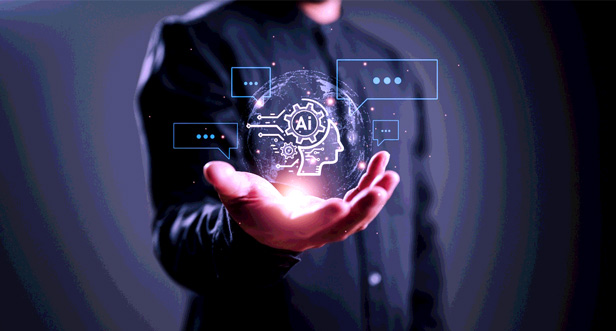October 12, 2023
Ask Us Anything: How Will AI Change Promo?
A supplier and distributor with strong technology backgrounds share insights regarding the role artificial intelligence might play in shaping the merch business.
It might be a tad bit of an understatement to say that artificial intelligence is a hot topic across industries. From C-Suite executives to first-year workers, everyone wants to know how AI could affect the nature of work – and society more broadly – in the years ahead.
Promotional products professionals are among the deeply curious.

Earlier this year, ASI Media created a series of articles and multimedia content on artificial intelligence and promo for a special “AI Week” report. Topics covered included everything from AI-powered distribution center robots to generative AI.
Now, two industry executives with strong technology backgrounds – one a supplier, one a distributor – weigh in with new key insights on how artificial intelligence is already being used in promo and how it may influence the industry in years ahead.
DISTRIBUTOR VIEW

Vic Berggren
• Owner of Printing Studio (asi/789642)
• Formerly a Chief Information Officer at a Technology Company
SUPPLIER VIEW

Jon Norris
• Vice President of Business Process Improvement, Hit Promotional Products (asi/61125)
• Counselor’s 2019 Technology Executive of the Year
Q: WHAT BENEFITS WILL AI BRING TO PROMO?
VB: Promo is well-positioned to benefit from generative AI models. This industry already has a tremendous amount of data, product detail, attributes, personalization options, colors, sizes and sales data. Generative AI models can look at all that and your customer data and trends to generate new outcomes, with “new outcomes” meaning new products that designers haven’t thought of yet. Speaking most broadly, we’ll see tools that help streamline product design, sales, marketing and operations, and that produce more personalized recommendations and better customer analysis.
JN: We’ll see better customer service, workflow process improvements, better product selections, real-time data analysis, faster issue resolution, an automated proofing process, replacement of offshored positions, quick webstore designs, rapid software development for customization – and robots. But other than that, not much…
Q: WHAT ABOUT NEGATIVE EFFECTS?
VB: People are concerned about job loss. Still, AI tools require a human touch. People who see this as an opportunity will adopt the skills quickly and evolve. There will be demand for those who can leverage AI effectively.
JN: Our industry has been insulated from disruption by the complexities of processing millions of customized orders each year. AI will simplify those complexities, but will that make us more subject to disruption? Time will tell. I also expect job impacts, first in positions that involve repetitive tasks with documented processes and next in graphics as users master text-based prompts for things like logo creation.
Introducing AI Search in ESP+
AI in ESP+ provides product ideas suited for your clients in seconds. Instruct the AI to come up with product ideas for an upcoming project and it will generate them based on insight from your preferences, projects, client information and more. Try it now at espplus.com.
Q: HOW ARE YOU CURRENTLY USING AI?
VB: I use AI to help create short videos that help power our social media marketing efforts. Tools like ChatGPT help enhance the video scripts and an AI-based speech synthesizer, ElevenLabs.io, converts the scripts into a voice far more captivating than my own. ElevenLabs also produces an MP3 file that I upload to edit my timing and transitions to create my finished product. Additionally, I use Lexica.ai to generate headwear images. I ask Lexica to design a hat, and I use those results to post as content on Twitter. I share the prompt I used to help people understand what’s possible.
JN: I use it to fuel personal productivity. For instance, I use ChatGPT to write job descriptions, presentation outlines, press releases and blog posts. I’ve also played with uploading Excel files and data sets for real-time analysis. While crude, with the right prompts, ChatGPT can output charts and thoughtful analysis. More broadly, I think you’ll see adopters using AI to generate a more intuitive subset of keywords, to help in quality control, and to process orders.
In this Promo Insiders podcast, futurist, technologist, consultant and author David Espindola discusses the future of sales roles, manufacturing work and other jobs in the AI age.
IN WHAT WAYS WILL AI INFLUENCE PRODUCT DEVELOPMENT?
VB: Generative AI models will play a significant role in creating new designs based on trends, consumer preferences and existing content. These models will be capable of generating many potential new product designs based on specific criteria. Also, machine learning could help analyze sales and product data to make predictions about trends or recommendations.
JN: As generative AI becomes more prevalent, you’ll see the usage of AI-generated product design. There have already been industry blog posts where users have created backpacks, though admittedly they weren’t great. Still, as the worlds of generative AI engines like Dall-E 2 and Stable Diffusion grow in their abilities and cross paths with the CAD designers of the world, watch out.
Q: HOW MIGHT AI IMPACT END-USERS/END-BUYERS’ USE OF PROMO PRODUCTS?
VB: It has the potential to make products more valuable. With enough customer data, AI could likely generate product designs completely tailored to an individual customer, resulting in something that might be more likely to be used and appreciated. That helps create a repeat customer.
JN: Digital art, internet, social media – all haven’t unseated the promotional product and AI won’t kill it either. I hope that companies will utilize AI to closely match products to individuals and then perform real-time analytics. AI can help prove the ROI of our products.
